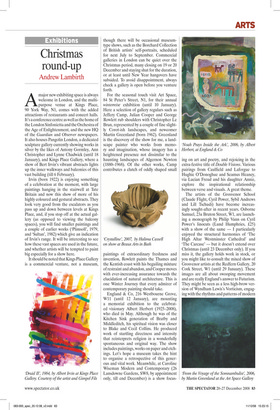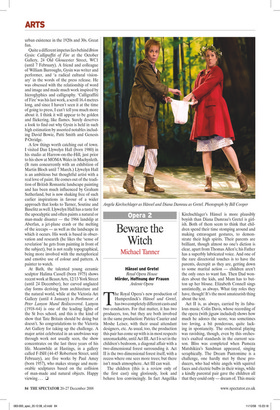Christmas round-up
Andrew Lambirth
Amajor new exhibiting space is always welcome in London, and the multipurpose venue at Kings Place, 90 York Way, N1, comes with the added attractions of restaurants and concert halls. It’s a conference centre as well as the home of the London Sinfonietta and the Orchestra of the Age of Enlightenment, and the new HQ of the Guardian and Observer newspapers. It also houses Pangolin London, a dedicated sculpture gallery currently showing works in silver by the likes of Antony Gormley, Ann Christopher and Lynne Chadwick (until 18 January), and Kings Place Gallery, where a show of Bert Irvin’s vibrant abstracts lights up the inner walkways and balconies of this vast building (till 6 February).
Irvin (born 1922) is enjoying something of a celebration at the moment, with large paintings hanging in the stairwell at Tate Britain and now this show of more of his highly coloured and gestural abstracts. They look very good from the escalators as you pass up and down between levels at Kings Place, and, if you stop off at the actual gallery (as opposed to viewing the balcony spaces), you will find smaller paintings and a couple of earlier works (‘Plimsoll’, 1979, and ‘Sultan’, 1982) which give an indication of Irvin’s range. It will be interesting to see how these vast spaces are used in the future, and whether artists will be tempted to paint big especially for a show here.
It should be noted that Kings Place Gallery is a commercial venture, not a museum, though there will be occasional museumtype shows, such as the Borchard Collection of British artists’ self-portraits, scheduled for next July to September. Commercial galleries in London can be quiet over the Christmas period, many closing on 19 or 20 December and staying shut for the duration, or at least until New Year hangovers have subsided. To avoid disappointment, always check a gallery is open before you venture forth.
For the seasonal touch visit Art Space, 84 St Peter’s Street, N1, for their annual winterreise exhibition (until 10 January). Here a selection of gallery regulars such as Jeffery Camp, Julian Cooper and George Rowlett rub shoulders with Christopher Le Brun, represented by a couple of fine slightly Corot-ish landscapes, and newcomer Martin Greenland (born 1962). Greenland is the discovery of the show for me, a landscape painter who works from memory and imagination, whose imagery has a heightened presence not dissimilar to the haunting landscapes of Algernon Newton (1880–1968). Of the other works, Camp contributes a clutch of oddly shaped small paintings of extraordinary freshness and invention, Rowlett paints the Thames and the Kentish coast with his beguiling mixture of restraint and abandon, and Cooper moves with ever-increasing assurance towards the elucidation of natural architecture. This is one Winter Journey that every admirer of contemporary painting should take.
England & Co, 216 Westbourne Grove, W11 (until 12 January), are mounting a memorial exhibition to the celebrated visionary Albert Herbert (1925–2008), who died in May. Although he was of the Kitchen Sink generation of Bratby and Middleditch, his spiritual vision was closer to Blake and Cecil Collins. He produced work of startling directness and intensity that reinterprets religion in a wonderfully spontaneous and original way. The show includes paintings, works on paper and etchings. Let’s hope a museum takes the hint to organise a retrospective of this generous and vital work. Meanwhile, at Caroline Wiseman Modern and Contemporary (26 Lansdowne Gardens, SW8, by appointment only, till end December) is a show focus ing on art and poetry, and rejoicing in the extra-festive title of Double Visions. Various pairings from Caulfield and Laforgue to Hughie O’Donoghue and Seamus Heaney, via Lucian Freud and his daughter Annie, explore the inspirational relationship between verse and visuals. A great theme.
The artists of the Grosvenor School (Claude Flight, Cyril Power, Sybil Andrews and Lill Tschudi) have become increasingly sought-after in recent years. Osborne Samuel, 23a Bruton Street, W1, are launching a monograph by Philip Vann on Cyril Power’s linocuts (Lund Humphries, £25) with a show of the same — I particularly enjoyed the structural harmonies of ‘The High Altar Westminster Cathedral’ and ‘The Carcase’ — but it doesn’t extend over Christmas (until 23 December only). If you miss it, the gallery holds work in stock, or you might like to consult the mixed show of Grosvenor artists at the Redfern Gallery, 20 Cork Street, W1 (until 29 January). These images are all about swooping movement and are really England’s answer to Futurism. They might be seen as a less high-brow version of Wyndham Lewis’s Vorticism, engaging with the rhythms and patterns of modern urban existence in the 1920s and 30s. Great fun.
Quite a different impetus lies behind Brion Gysin: Calligraffiti of Fire at the October Gallery, 24 Old Gloucester Street, WC1 (until 7 February). A friend and colleague of William Burroughs, Gysin was writer and performer, and ‘a radical cultural visionary’ in the words of the press release. He was obsessed with the relationship of word and image and made much work inspired by hieroglyphics and calligraphy. ‘Calligraffiti of Fire’ was his last work, a scroll 16.4 metres long, and since I haven’t seen it at the time of going to press, I can’t tell you much more about it. I think it will appear to be golden and flickering, like flames. Surely deserves a look to find out why Gysin is held in such high estimation by assorted notables including David Bowie, Patti Smith and Genesis P-Orridge.
A few things worth catching out of town. I visited Dan Llywelyn Hall (born 1980) in his studio at Harrow-on-the-Hill, just prior to his show at MOMA Wales in Machynleth. (It runs concurrently with an exhibition of Martin Bloch until 7 March.) Llywelyn Hall is an ambitious but thoughtful artist with a real love of paint. He comes out of the tradition of British Romantic landscape painting and has been much influenced by Graham Sutherland, but is now shaking free of such earlier inspirations in favour of a wider approach that looks to Turner, Soutine and Baselitz as well. Llywelyn Hall has a taste for the apocalyptic and often paints a natural or man-made disaster — the 1966 landslip at Aberfan, a jet-plane crash or the melting of the icecaps — as well as the landscape in which it occurs. His work is based in observation and research (he likes the ‘sense of revelation’ he gets from painting in front of the subject), but is not really topographical, being more involved with the metaphorical and emotive use of colour and pattern. A painter to watch.
At Bath, the talented young ceramic sculptor Halima Cassell (born 1975) shows recent work at Beaux Arts, 12/13 York Street (until 24 December), her carved unglazed clay forms deriving from architecture and the natural world, while at the Victoria Art Gallery (until 4 January) is Porthmeor: A Peter Lanyon Mural Rediscovered. Lanyon (1918–64) is one of the leading lights of the St Ives school, and this is the kind of show that Tate Britain should be doing but doesn’t. So congratulations to the Victoria Art Gallery for taking up the challenge. A major artist celebrated in an unobvious way through work not usually seen, the show concentrates on the last three years of his life. Meanwhile at Hastings, in a gallery called F-ISH (44-45 Robertson Street, until February), are five works by Paul Amey (born 1957), who makes strange and memorable sculptures based on the collision of man-made and natural objects. Happy viewing ... ❑























































































































 Previous page
Previous page